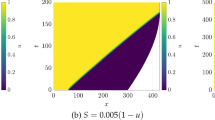Abstract
Turing reaction–diffusion systems have been used to model pattern formation in several areas of developmental biology. Previous biomathematical Turing system models employed static domains which failed to incorporate the growth that inherently occurs as an organism develops. To address this shortcoming, we incorporate an exponentially growing domain into a Turing system, allowing one to more realistically model biological pattern formation. This Turing system can generate patterns on an exponentially growing domain in any of the eleven coordinate systems in which the Helmholtz equation is separable, making the system incredibly flexible and giving one the capability to mathematically model pattern formation on a geometrically diverse group of domains. Linear stability analysis is employed to generate mathematical conditions which ensure such a system can generate patterns. We apply the exponentially growing Turing system to a prolate spheroidal domain and conduct numerical simulations to investigate the system’s pattern-generating behavior. We find that the addition of growth to a Turing system causes a significant change in the pattern-generating behavior of the system. While a static domain Turing system converges to a final pattern, an exponentially growing domain Turing system produces transient patterns that continually evolve and increase in complexity over time.




Similar content being viewed by others
References
Barrio, R.: Turing systems: a general model for complex patterns in nature. Electron J. Theor. Phys. 4(15), 1–26 (2007)
Barrio, R., Baker, R., Vaughan, B., Tribuzy, K., de Carvalho, M., Bassanezi, R., Maini, P.: Modeling the skin pattern of fishes. Phys. Rev. E 79(3), 031,908–1–031,908–11 (2009)
Barrio, R., Varea, C., Aragon, J., Maini, P.: A two-dimensional numerical study of spatial pattern formation in interacting turing systems. B Math. Biol. 61(3), 483–505 (1999)
Ermentrout, B.: Stripes or spots? Nonlinear effects in bifurcation of reaction–diffusion equations on the square. Proc. R. Soc. Lond. A Math. 434(1891), 413–417 (1991)
Flammer, K.: Spheroidal Wave Functions. Stanford University Press, Palo Alto (1957)
Gierer, A., Meinhardt, H.: A theory of biological pattern formation. Kybernetik 12, 30–39 (1972)
Gjorgjieva, J., Jacobsen, J.: Turing patterns on growing spheres: the exponential case. Discrete Cont. Dyn. Syst. Suppl. 2007, 436–445 (2007)
Leppänen, T.: Computational studies of pattern formation in turing systems. Ph.D. thesis, Helsinki University of Technology (2004)
Leppänen, T., Karttunen, M., Barrio, R., Kaski, K.: Morphological transitions and bistability in turing systems. Phys. Rev. E. 70, 066,202 (2004). doi:10.1103/PhysRevE.70.066202
Morton, K., Mayers, D.: Numerical Solution of Partial Differential Equations: an Introduction, 2nd edn. Cambridge University Press, Cambridge (2005)
Murray, J.: Mathematical Biology II, 3rd edn. Springer, New York (2003)
Plaza, R., Sanchez-Garduno, F., Padilla, P., Barrio, R., Maini, P.: The effect of growth and curvature on pattern formation. J. Dyn. Differ. Equ. 16(4), 1093–1121 (2004)
Sick, S., Reinker, S., Timmer, J., Schlake, T.: Hair follicle spacing through a reaction-diffusion mechanism. Science 314, 1447–1450 (2006)
Striegel, D., Hurdal, M.: Chemically based mathematical model for development of cerebral cortical folding patterns. PLoS Comput. Biol. 5(9), e1000,524 (2009)
Turing, A.: The chemical basis of morphogenesis. Philos. Trans. R. Soc. B 237, 37–72 (1952)
Varea, C., Hernandez, D., Barrio, R.: Soliton behaviour in a bistable reaction diffusion model. J. Math. Biol. 54, 797–813 (2007)
Venkataraman, C., Sekimura, T., Gaffney, E., Maini, P., Madzvamuse, A.: Modeling parr-mark pattern formation during the early development of Amago trout. Phys. Rev. E. 84, 041,923 (2011). doi:10.1103/PhysRevE.84.041923
Zwillinger, D.: Handbook of Differential Equations. Academic Press, San Diego (1989)
Author information
Authors and Affiliations
Corresponding author
Rights and permissions
About this article
Cite this article
Toole, G., Hurdal, M.K. Pattern Formation in Turing Systems on Domains with Exponentially Growing Structures. J Dyn Diff Equat 26, 315–332 (2014). https://doi.org/10.1007/s10884-014-9365-2
Received:
Revised:
Published:
Issue Date:
DOI: https://doi.org/10.1007/s10884-014-9365-2




